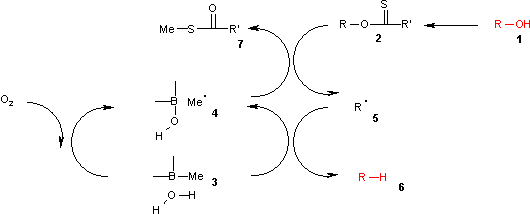| Barton–McCombie deoxygenation | |
|---|---|
| Named after | Derek Harold Richard Barton Stuart W. McCombie |
| Reaction type | Organic redox reaction |
| Identifiers | |
| Organic Chemistry Portal | barton-mccombie-reaction |
| RSC ontology ID | RXNO:0000134 |
The Barton–McCombie deoxygenation is an organic reaction in which a hydroxy functional group in an organic compound is replaced by a hydrogen to give an alkyl group. It is named after British chemists Sir Derek Harold Richard Barton and Stuart W. McCombie.

This deoxygenation reaction is a radical substitution. In the related Barton decarboxylation the reactant is a carboxylic acid.
Mechanism
The reaction mechanism consists of a catalytic radical initiation step and a propagation step. The alcohol (1) is first converted into a reactive carbonothioyl intermediate such as a thionoester or xanthate 2. Heating of AIBN results in its homolytic cleavage, generating two 2-cyanoprop-2-yl radicals 9, which each abstract a hydrogen from tributylstannane 3 to generate tributylstannyl radicals 4 and inactive 10. The tributyltin radical abstracts the xanthate group from 2 by attack of 4 at the sulfur atom with concurrent homolytic cleavage of the C-S π bond. This leaves a carbon centered radical that forms a C-O π bond through homolytic cleavage of the R-O σ bond, giving alkyl radical 5 and tributyltin xanthate 7. The sulfur tin bond in this compound is very stable and provides the driving force for this reaction. The alkyl radical 5 then abstracts a hydrogen atom from a new molecule of tributylstannane generating the desired deoxygenated product (6) and a new radical species ready for propagation.

Variations
Nearby radical-stabilizing moieties can capture the radical intermediate from the thionoester fission, as in a total synthesis of azadirachtin:

Alternative thiocarbonyls
Other thiocarbonyl reagents can replace the thioacyl chloride. In one variation the reagent is the imidazole 1,1'-thiocarbonyldiimidazole (TCDI), for example in the total synthesis of pallescensin B. TCDI is especially good to primary alcohols because there is no resonance stabilization of the xanthate; the nitrogen lonepair is involved in the aromatic sextet.
The reaction also applies to S-alkylxanthates.
Alternative hydrogen sources
The main disadvantage to Barton-McCombie deoxygenation is the toxic and expensive tributylstannane, the endproducts of which are difficult to remove from the reaction mixture. One alternative is tributyltin oxide as the radical source and poly(methylhydridesiloxane) (PMHS) as the hydrogen source.

Both roles are combined in the trialkylboranes, which can abstract the required hydrogen atoms from protic solvents, the reactor wall or even (in strictly anhydrous conditions) the borane itself. Typically the reagents are trimethylborane or triethylborane contaminated with small amounts of water.

The catalytic cycle begins when air oxidizes the trialkylborane 3 to the borinic acid and methyl radical 4. This radical methylates the xanthate 2, which fragments to S-methyl-S-methyl dithiocarbonate 7 and the radical intermediate 5. 5 abstracts a hydrogen from the borane 3 to reform 4 and produce the alkane 6.

Theoretical calculations suggest that O-H homolysis in a borane-water complex is endothermic, but the energy barrier is comparable to tributylstannane and not pure water homolysis.
See also
References
- Barton, D. H. R.; McCombie, S. W. (1975). "A new method for the deoxygenation of secondary alcohols". J. Chem. Soc., Perkin Trans. 1. 16 (16): 1574–1585. doi:10.1039/P19750001574.
- Crich, D.; Quintero, L. (1989). "Radical chemistry associated with the thiocarbonyl group". Chem. Rev. 89 (7): 1413–1432. doi:10.1021/cr00097a001.
- Forbes, J.E.; Zard, S.Z. (January 1989). "A novel radical chain reaction of xanthic anhydrides. Further observations on the intermediacy of alkoxy-thiocarbonyl radicals in the Barton-McCombie reaction". Tetrahedron Letters. 30 (33): 4367–4370. doi:10.1016/s0040-4039(00)99362-6.
- Synthesis of Azadirachtin: A Long but Successful Journey Gemma E. Veitch, Edith Beckmann, Brenda J. Burke, Alistair Boyer, Sarah L. Maslen, and Steven V. Ley Angew. Chem. Int. Ed. 2007, doi:10.1002/anie.200703027
- The first total synthesis of (±)-pallescensin B Wen-Cheng Liu and Chun-Chen Liao ChemComm, 1999, 117–118 117 Article
- ^ Part 2. Mechanistic aspects of the reduction of S-alkyl-thionocarbonates in the presence of triethylborane and air Allais F, Boivin J, Nguyen V Beilstein J. Org. Chem., 2007 3:45 ( 12 December 2007 ) doi:10.1186/1860-5397-3-46
- Tormo, J.; Fu, G. C. (2002). "α-D-Ribo-hexofuranose, 3-deoxy-1,2:5,6-bis-O-(1-methylethylidene)". Org. Synth. 78: 239. doi:10.15227/orgsyn.078.0239.
- Deoxygenation of Alcohols Employing Water as the Hydrogen Atom Source David A. Spiegel, Kenneth B. Wiberg, Laura N. Schacherer, Matthew R. Medeiros, and John L. Wood J. Am. Chem. Soc. 2005, 127, 12513-12515. (doi:10.1021/ja052185l)
